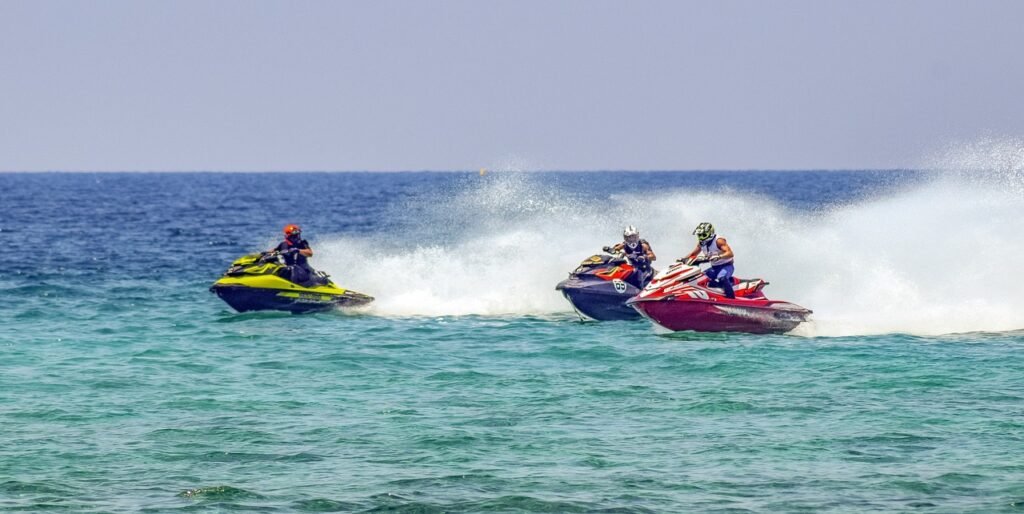This post may contain affiliate links, which means that I may make a small commission off items you purchase at no additional cost to you. Please see my terms of use page for details.
Are you ready for a thrilling ride into the world of Jetski Racing Competitions? In the racing and competitive scene, one brand has stood out among the rest – Yamaha. With its superior performance and innovative features, Yamaha has consistently dominated the racing scene in jetski racing competitions. But what about other manufacturers like Seadoo, Kawasaki, and Honda?
Many enthusiasts have their own opinions about these brands, and there are debates about which one is more reliable. So, buckle up as we dive into the exhilarating world of jetski racing competitions and explore the strengths and weaknesses of each manufacturer. Get ready to discover why Yamaha has reigned supreme in the racing scene while uncovering the fascinating insights that make each brand unique.
Checkout these two videos from my Youtube channel showing some awesome footage from the Pro Watercross National Tour at Tugaloo State Park in Lavonia, GA:
Yamaha in Jetski Racing Competitions
Yamaha, a leading manufacturer in the watercraft industry, has a notable history in jetski racing competitions. With a strong commitment to innovation and performance, Yamaha has made significant contributions to the competitive scene.
Yamaha’s History in Jetski Racing Competitions
Yamaha’s involvement in jetski racing competitions dates back several decades. They were among the pioneers who recognized the potential of personal watercraft as a competitive sport. Yamaha has been actively sponsoring and organizing racing events since the early days, fostering the growth and popularity of the sport.
Yamaha Models in the Racing Scene
Yamaha offers a range of models specifically designed for jetski racing. The Yamaha WaveRunner lineup includes high-performance watercraft equipped with powerful engines, agile handling, and cutting-edge technology. Models like the GP1800R and FX Series have become popular choices among professional racers due to their outstanding performance capabilities.
Yamaha’s Racing Achievements
Yamaha has achieved remarkable success in jetski racing competitions, consistently clinching titles in various prestigious events around the world. Their riders have dominated championships such as the International Jet Sports Boating Association (IJSBA) World Finals and the Pro Watercross Tour. Yamaha’s dedication to excellence and continuous improvement has propelled them to the forefront of the racing scene.
Yamaha’s Impact on the Competitive Scene
Yamaha’s involvement in jetski racing competitions has had a profound impact on the competitive scene. Their commitment to pushing the boundaries of performance and technology has set new standards in the industry. Yamaha’s success has inspired other manufacturers to innovate and further elevate the sport. By providing top-tier machines for racers, Yamaha has significantly contributed to the overall excitement and growth of the jet ski racing community.
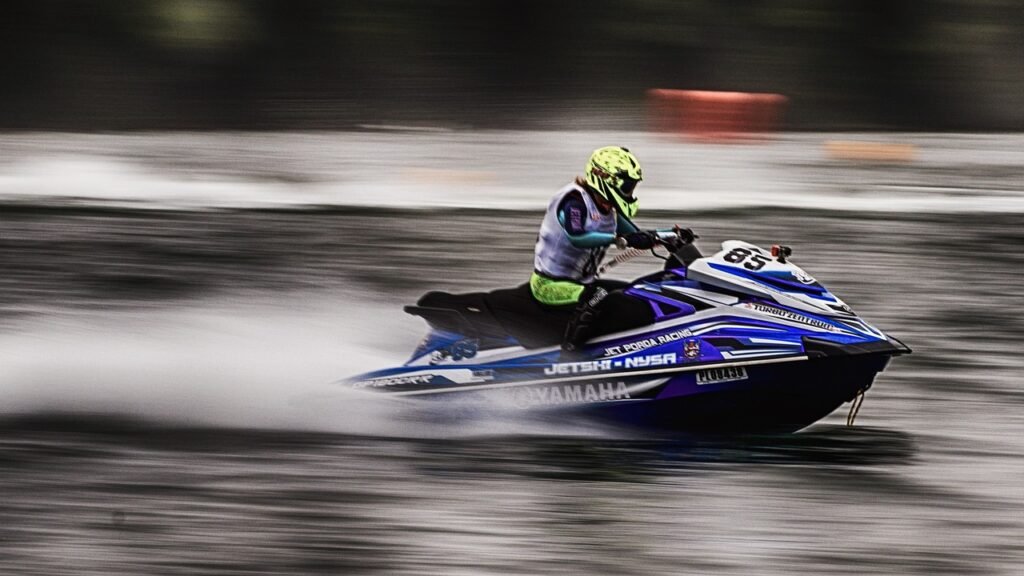
Seadoo in Jetski Racing Competitions
Seadoo, another prominent player in the watercraft industry, has also made its mark in jetski racing competitions. Their history in the sport, models, achievements, and impact have influenced the competitive scene.
Seadoo’s History in Jet Ski Racing Competitions
Seadoo has a rich history in jetski racing, with a legacy spanning decades. Recognizing the potential of personal watercraft as vessels for exhilarating competition, Seadoo has been actively involved in sponsoring and organizing racing events. Their commitment to the sport has contributed to its growth and popularity over the years.
Seadoo Models in the Racing Scene
Seadoo offers a diverse lineup of watercraft tailored for jetski racing. The Seadoo RXP-X and GTX models are highly regarded for their speed, agility, and precision handling. With powerful engines and advanced features, these models provide racers with the performance and control necessary to excel on the competitive circuit.
Seadoo’s Racing Achievements
Seadoo has achieved impressive success in jetski racing, consistently earning accolades in major competitions worldwide. Their riders have secured victories in events like the IJSBA World Finals and the Pro Watercross Tour. Seadoo’s commitment to performance and their dedication to supporting their riders have propelled them to the forefront of the racing scene.
Seadoo’s Impact on the Competitive Scene
Seadoo’s presence in jetski racing has had a significant impact on the competitive scene. Their relentless pursuit of performance and their willingness to push boundaries have catalyzed advancements in the sport. By continuously innovating and refining their machines, Seadoo has inspired a new generation of racers and helped elevate the sport’s overall competitiveness.
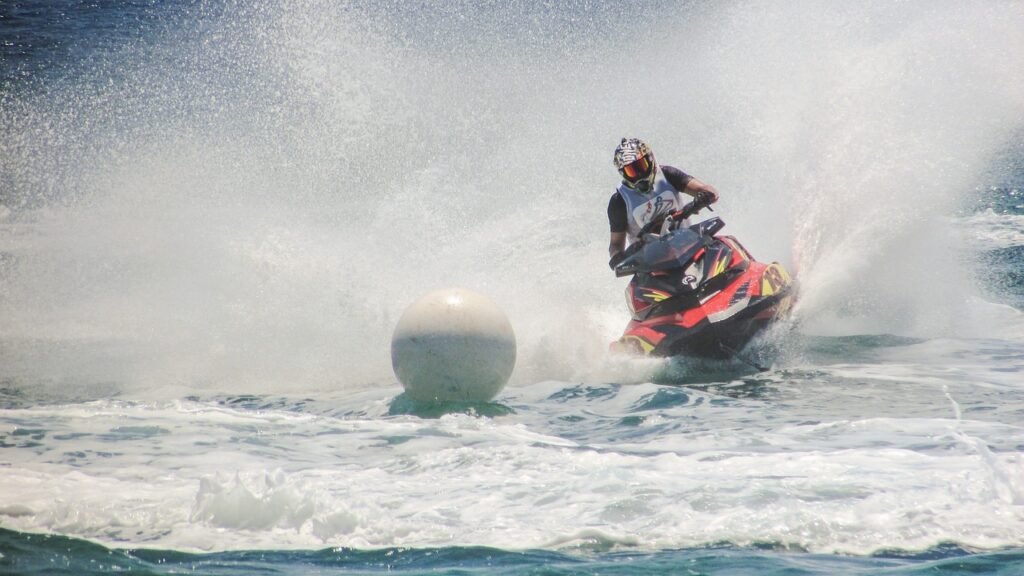
Kawasaki in Jetski Racing Competitions
Kawasaki, recognized globally for their extensive product range, has been an active participant in jet ski racing. Their history, models, achievements, and impact have contributed to the overall competitiveness of the sport.
Kawasaki’s History in Jetski Racing Competitions
Kawasaki has a longstanding involvement in jetski racing, dating back to the sport’s early days. They were among the first manufacturers to produce personal watercraft suitable for competitive racing. Recognizing the potential of jetski racing, Kawasaki actively supported and organized events to promote the sport’s growth.
Kawasaki Models in the Racing Scene
Kawasaki’s lineup of jetski models offers racers a combination of power, agility, and reliability. The Kawasaki Ultra, SX-R, and STX-15F are prominent models preferred by professional racers. These watercraft excel in terms of speed, maneuverability, and overall performance, making them formidable contenders on the racing circuit.
Kawasaki’s Racing Achievements
Kawasaki has enjoyed numerous successes in the realm of jetski racing. Their riders have secured victories in prestigious events like the IJSBA World Finals, X-Games, and national championships. Kawasaki’s commitment to performance, coupled with their focus on rider support and development, has propelled their team and machines to the forefront of the racing scene.
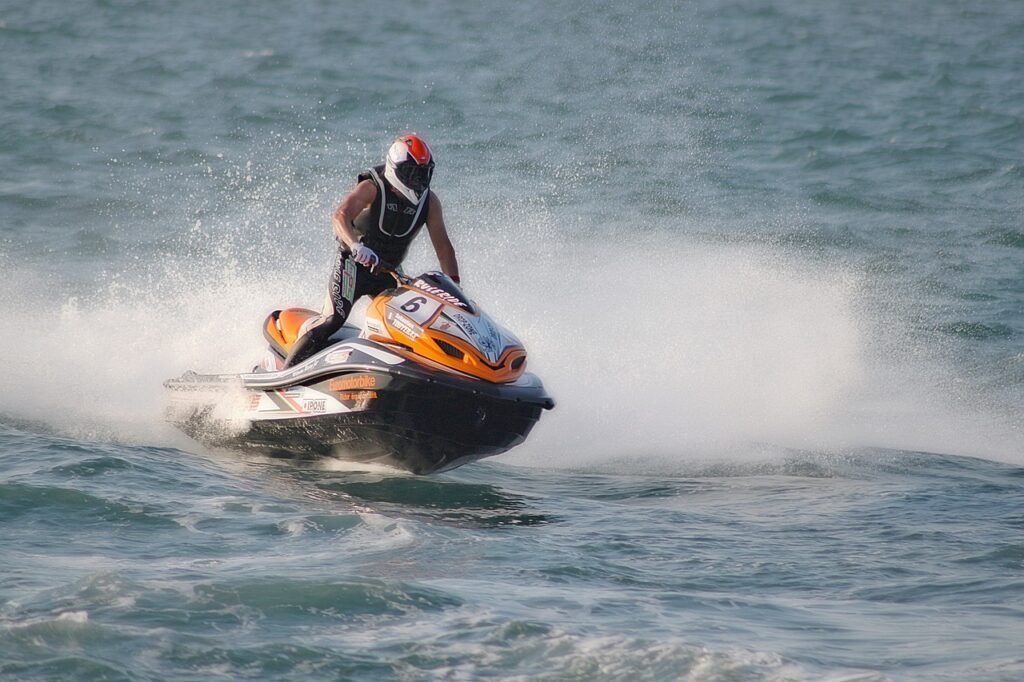
Kawasaki’s Impact on the Competitive Scene
Kawasaki’s involvement in jetski racing competitions has had a notable impact, contributing to the overall competitiveness of the sport. Their dedication to pushing the limits of performance and technology has not only elevated their own brand but has also inspired their competitors to innovate and improve. Kawasaki’s presence in the racing scene ensures a healthy rivalry, driving advancements and creating an electrifying atmosphere for both racers and fans.
Honda in Jetski Racing Competitions
Honda, renowned for its expertise in various industries, has also left its mark in jetski racing. Their involvement, models, achievements, and impact have influenced the competitive scene in distinctive ways.
Honda’s History in Jetski Racing Competitions
Honda’s foray into jetski racing began with a commitment to apply their engineering prowess to the sport. Understanding the demand for exhilarating personal watercraft, Honda entered the racing scene by developing high-performance models. Their participation in the competitive circuit further boosted the popularity of the sport.
Honda Models in the Racing Scene
Honda’s jetski models boast a blend of power, responsiveness, and reliability. The Honda Aquatrax F-12X and F-15X are notable examples that combine reliability, cutting-edge engineering with advanced features. These models offer racers optimal performance, ensuring a thrilling and competitive experience on the water. After riding multiple Honda F-12 and F-12X models, I personally have never ridden a more quiet jetski in my life, but electric models are being developed these days that may end up being just as quiet if not quieter.
Honda’s Racing Achievements
Honda has achieved significant success in jetski racing, leaving a lasting imprint on the sport. Their riders have claimed victories in various competitions around the world, including the IJSBA World Finals and national championships. Honda’s commitment to innovative design and constant improvement has allowed them to establish a reputation for excellence in the racing community.
Honda’s Impact on the Competitive Scene
Honda’s presence in jetski racing has had a substantial impact on the competitive scene. As a leading manufacturer renowned for their engineering prowess, Honda’s participation has inspired other manufacturers to innovate and elevate their game. Their commitment to performance, coupled with a focus on precision and reliability, has set new standards in the sport, fostering increased competition and captivating audiences.
Comparing the Manufacturers
When it comes to comparing the manufacturers in the jetski racing industry, several key factors come into play. These factors include performance and speed, reliability and durability, technological innovations, rider comfort and handling, as well as cost and affordability.
Performance and Speed
All four manufacturers, Yamaha, Seadoo, Kawasaki, and Honda, offer high-performance watercraft designed for racing. Each brand incorporates advanced engines and state-of-the-art features to maximize speed and maneuverability. Comparing the specific models, Yamaha’s GP1800R and Seadoo’s RXP-X are known for their exceptional speed, while Kawasaki’s Ultra and Honda’s Aquatrax showcase noteworthy acceleration and responsiveness on the water.
Reliability and Durability
Reliability and durability are crucial factors for racers, as they demand machines that can withstand the rigors of competitive racing. Yamaha, Seadoo, Kawasaki, and Honda have a reputation for producing watercraft that are robust and reliable. Each brand employs rigorous testing and quality control measures to ensure their jetskis can handle the demands of racing.
Technological Innovations
Technological innovations play a pivotal role in enhancing the performance and capabilities of jetskis. Yamaha, Seadoo, Kawasaki, and Honda continually invest in research and development to introduce cutting-edge features. Yamaha, with their RiDE technology and innovative hull designs, has made significant advancements in stability and control. Seadoo, on the other hand, has introduced intelligent suspension systems to enhance rider comfort and handling. Kawasaki and Honda, too, have made notable contributions in terms of technological innovations to improve overall performance.
Rider Comfort and Handling
Rider comfort and handling are essential aspects of jetski racing. Yamaha, Seadoo, Kawasaki, and Honda prioritize ergonomic design and rider-focused features in their watercraft. Each manufacturer offers varying levels of comfort and handling, with Seadoo often praised for their intuitiveness and precise handling, while Yamaha and Kawasaki are known for their stability and ease of maneuverability. Honda, with their focus on engineering excellence, creates machines that offer a harmonious blend of comfort and performance.
Cost and Affordability
The cost and affordability of jetskis can vary among the manufacturers. Factors such as the model, features, and specifications influence the price range. While it is difficult to pinpoint a clear winner in terms of cost and affordability, it is worth noting that Yamaha and Seadoo, with their extensive model lineup, offer options across different price ranges. Kawasaki and Honda, known for their engineering excellence, often incorporate premium features in their models, resulting in slightly higher price points.
Opinions on Brand Reliability
Opinions on brand reliability can vary among individuals based on personal experiences and perceptions. Customer reviews and feedback, expert analysis and insights, and manufacturer reputation are factors that influence opinions on brand reliability.
Customer Reviews and Feedback
Customer reviews and feedback provide valuable insights into the reliability of jetski brands. Positive reviews highlighting durability, ease of maintenance, and overall performance contribute to a brand’s reputation for reliability. Conversely, negative reviews and criticisms related to mechanical issues, frequent breakdowns, or poor customer support can affect how individuals perceive a brand’s reliability. It is advisable to consider a wide range of reviews and feedback from various sources to gain a comprehensive understanding.
Expert Analysis and Insights
Expert analysis and insights provide an objective evaluation of jetski brands. Experts examine factors such as build quality, engineering, performance, and long-term reliability when assessing the reliability of different manufacturers. Their analyses can help individuals make informed decisions and understand the strengths and weaknesses of each brand.
Manufacturer Reputation
Manufacturer reputation plays a significant role in shaping opinions on brand reliability. Establishing a reliable and trustworthy reputation takes time as manufacturers consistently produce high-quality products and provide excellent customer service. Yamaha, Seadoo, Kawasaki, and Honda, with their long-standing presence in the industry and commitment to innovation, have earned reputations for reliability. Consistency in delivering durable and dependable watercraft contributes to their positive brand image.
Factors Influencing Brand Dominance
Brand dominance in the jet ski racing industry can be influenced by various factors that contribute to a manufacturer’s overall success. These factors include racing team and sponsorships, research and development investments in technology, rider performance and skills, marketing and promotion strategies, as well as the availability of aftermarket upgrades.
Checkout the video below which shows one of the skis that is considered to be the fastest in the world, it just happens to be a Yamaha:
Racing Team and Sponsorships
A strong racing team, comprised of talented riders, can significantly contribute to a brand’s dominance in the competitive scene. Yamaha, Seadoo, Kawasaki, and Honda actively support and sponsor racing teams, providing racers with the necessary resources to excel. A cohesive racing team equipped with skilled riders and ongoing support enhances a brand’s visibility and performance, ultimately contributing to brand dominance.
R&D Investments and Technology
Strategic investments in research and development (R&D) enable manufacturers to stay at the forefront of technological advancements. Yamaha, Seadoo, Kawasaki, and Honda continually invest in R&D to refine their machines, focusing on improving speed, handling, and overall performance. By leveraging emerging technologies, such as intelligent suspension systems and advanced engine designs, manufacturers can gain a competitive edge and solidify their brand dominance.
Rider Performance and Skills
Rider performance and skills play a crucial role in brand dominance. Regardless of the manufacturer, skilled and talented riders are essential for achieving success in competitions. Brands that actively train and support their riders, providing them with the necessary tools and resources for improvement, enhance their chances of dominating the competitive scene. The skills, dedication, and accomplishments of individual riders can significantly impact a brand’s overall reputation and dominance.
Marketing and Promotion
Effective marketing and promotion strategies give manufacturers a competitive advantage by increasing brand visibility and attracting new customers. Yamaha, Seadoo, Kawasaki, and Honda employ various tactics to promote their racing heritage, technological advancements, and overall brand values. Engaging social media campaigns, partnerships with influencers and athletes, as well as strategic advertising, contribute to sustained brand dominance.
Availability of Aftermarket Upgrades
The availability of aftermarket upgrades can also influence brand dominance. Racers and enthusiasts often seek modifications to enhance performance or customize their machines. Manufacturers that provide a wide range of aftermarket parts and accessories cater to the demands of their customer base, fostering loyalty and brand dominance. Yamaha, Seadoo, Kawasaki, and Honda have established partnerships with aftermarket suppliers, ensuring a diverse range of upgrade options for their customers.
Fanbase and Brand Loyalty
Fanbase and brand loyalty contribute to the success and dominance of a manufacturer in the jetski racing industry. Building a passionate and engaged fanbase requires cultivating brand identity, fostering fan engagement and community, maintaining an established racing tradition, and establishing a strong social media presence.
Brand Identity and Image
Brand identity and image are crucial for developing a dedicated fanbase and fostering brand loyalty. Yamaha, Seadoo, Kawasaki, and Honda have distinct brand identities, each appealing to different demographics. Yamaha’s reputation for innovation and reliability attracts tech-savvy individuals, while Seadoo’s focus on performance and adrenaline appeals to thrill-seekers. Kawasaki’s long-standing racing heritage and Honda’s engineering excellence also contribute to their unique brand identities, resonating with specific target markets.
Fan Engagement and Community
Engaging with fans and fostering a sense of community is essential for establishing brand loyalty. Manufacturers organize fan events, sponsor social gatherings, and create online platforms where enthusiasts can connect and share their experiences. Yamaha, Seadoo, Kawasaki, and Honda actively engage with their fanbase through social media, websites, and dedicated forums, creating a sense of belonging and strengthening brand loyalty.
Established Racing Tradition
An established racing tradition enhances brand loyalty by evoking a sense of heritage and prestige. Yamaha, Seadoo, Kawasaki, and Honda have all been involved in jetski racing for decades, accumulating a rich racing tradition. Their consistent participation in renowned events, victories, and support of racing teams further solidify their racing pedigrees, fostering a loyal fanbase.
Social Media Presence
In today’s digital age, a strong social media presence is vital for connecting with fans and solidifying brand loyalty. Yamaha, Seadoo, Kawasaki, and Honda leverage various social media platforms to engage with their audience, provide updates on racing achievements, showcase new products, and interact with enthusiasts. Active social media participation enables manufacturers to maintain a strong connection with their fanbase, driving brand loyalty and dominance.
Expanding the Competitive Scene
Continued growth and expansion of the jetski racing industry rely on several key factors. Promoting diversity and inclusivity, encouraging young talent, internationalizing competitions, exploring innovative race formats, and fostering collaboration among manufacturers all contribute to the expansion and development of the competitive scene.
Promoting Diversity and Inclusivity
Promoting diversity and inclusivity is vital for ensuring a vibrant and inclusive jetski racing community. Efforts to encourage participation from all demographics and backgrounds create a welcoming environment for racers and fans. Yamaha, Seadoo, Kawasaki, and Honda, along with racing organizations, can actively promote diversity and inclusivity through targeted initiatives, training programs, and awareness campaigns.
Encouraging Young Talent
Nurturing young talent is essential for the long-term growth and sustainability of the sport. Manufacturers can collaborate with racing organizations, academies, and junior development programs to identify and support promising young riders. Scholarships, mentorship programs, and sponsorships can help young talents pursue their passion for jetski racing and ensure a continuous influx of skilled racers.
Internationalization of Competitions
Jetski racing competitions can be expanded by fostering internationalization. Organizing races in different regions of the world increases participation, diversifies talent pools, and attracts a more global audience. Encouraging manufacturers to establish partnerships and support regional competitions can stimulate the growth of the sport internationally.
Innovation in Race Formats
Innovation in race formats can introduce fresh excitement to the competitive scene. Manufacturers, racing organizations, and event organizers can collaborate to create new race formats that challenge riders and captivate audiences. Incorporating elements such as freestyle competitions, team events, and endurance races can bring a dynamic and diverse experience to both racers and spectators.
Collaboration among Manufacturers
Collaboration among manufacturers plays a significant role in expanding the competitive scene. Joint initiatives, such as shared research and development projects or collaborative events, can introduce new perspectives and drive innovation in the industry. By working together, Yamaha, Seadoo, Kawasaki, and Honda can collectively elevate the sport, benefiting racers, fans, and the overall growth of jetski racing.
Future Outlook and Speculations
The future outlook of the jetski racing industry holds several exciting possibilities and potential challenges. Factors such as the evolution of jetski technology, emerging competition in the market, strategies for brand domination, impact of environmental concerns, and the integration of electric jet skis are all areas of interest for enthusiasts and industry players alike.
Evolution of Jetski Technology
The continuous evolution of jet ski technology promises exciting advancements in speed, performance, and efficiency. Manufacturers like Yamaha, Seadoo, Kawasaki, and Honda will continue to invest in research and development, pushing the boundaries of what is possible. Innovations such as improved hull designs, smarter engine management systems, and enhanced safety features will likely shape the future of jetski racing.
Emerging Competition in the Market
While Yamaha, Seadoo, Kawasaki, and Honda have long dominated the jetski racing market, emerging competitors may disrupt the status quo. New manufacturers entering the industry with innovative designs, competitive pricing, and unique features can introduce fresh competition and diversify the market. This healthy competition will spur further advancements and benefit the overall competitiveness of the sport.
Strategies for Brand Domination
Manufacturers will employ various strategies to solidify their brand domination and maintain a competitive edge. Continual investments in research and development, rider support programs, and sponsorships will remain crucial. Additionally, manufacturers that understand and cater to the evolving preferences of racers and enthusiasts, such as customization options and professional collaborations, will be well-positioned for long-term success.
Impact of Environmental Concerns
As environmental concerns become increasingly important, manufacturers will face pressure to develop sustainable and eco-friendly solutions. Yamaha, Seadoo, Kawasaki, and Honda will likely focus on reducing emissions, improving fuel efficiency, and exploring alternative power sources. Environmentally responsible practices and the development of electric jet skis will likely shape the future of the industry, taking into account the need for sustainability in racing competitions.
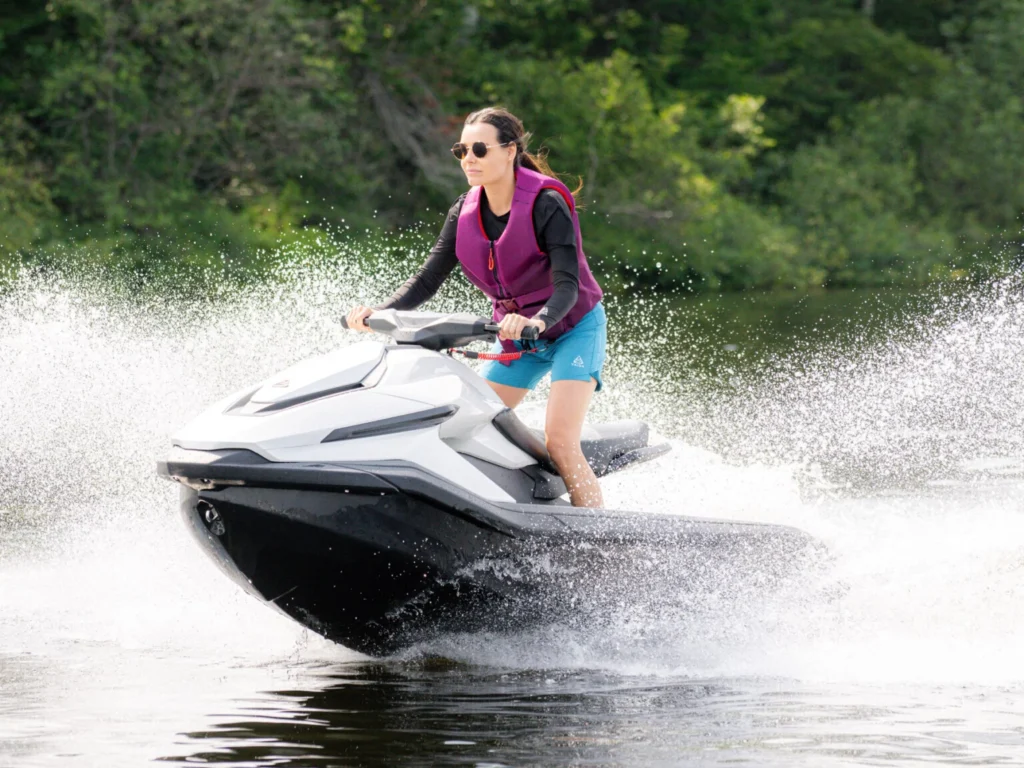
Integration of Electric Jetskis
The integration of electric jet skis presents an exciting opportunity for the future of the sport. As advancements in battery technology continue, electric jetskis will become more viable and practical for racing. Yamaha, Seadoo, Kawasaki, and Honda, with their established presence and engineering expertise, will likely be at the forefront of this transition. Electric jetskis offer the potential for quieter rides, reduced environmental impact, and novel performance capabilities, ushering in a new era of jet ski racing. The future of jetskis is evolving and every manufacturer still in the game will need to adapt and evolve to stay competitive in the industry. Who knows what tomorrow will bring…..
Related Articles:
Curious About The Powerful Yamaha Jetski Engines? Here’s the Inside Scoop!
How Well Does A Yamaha Jetski Hold Its Value Compared To Other Brands?

